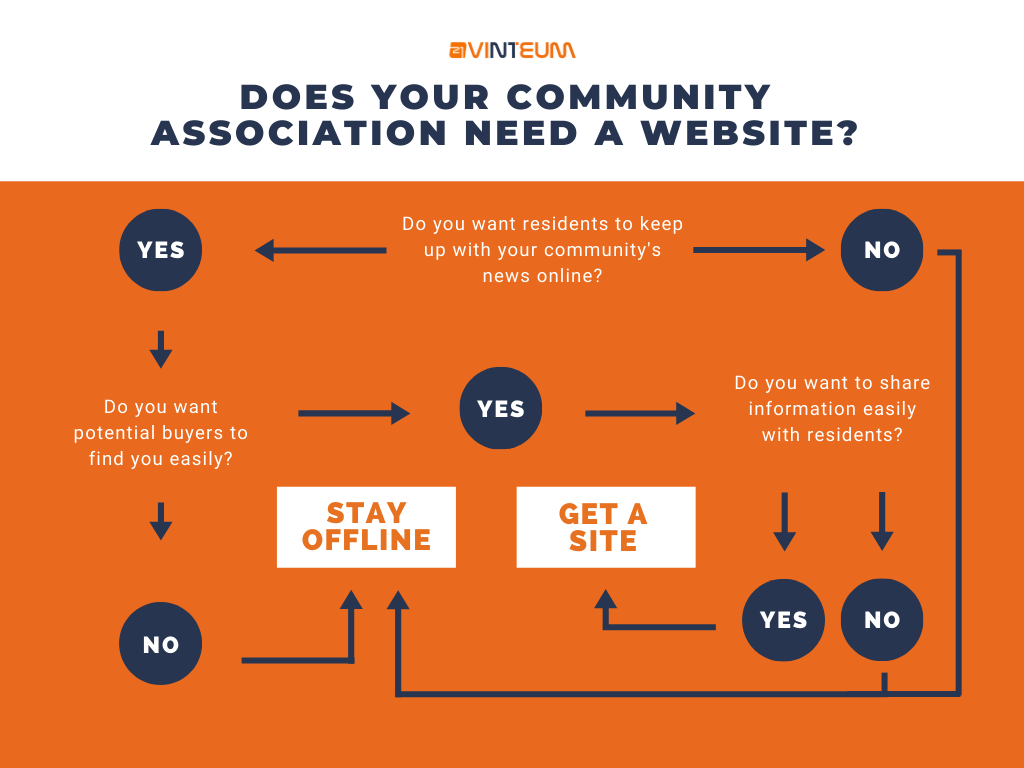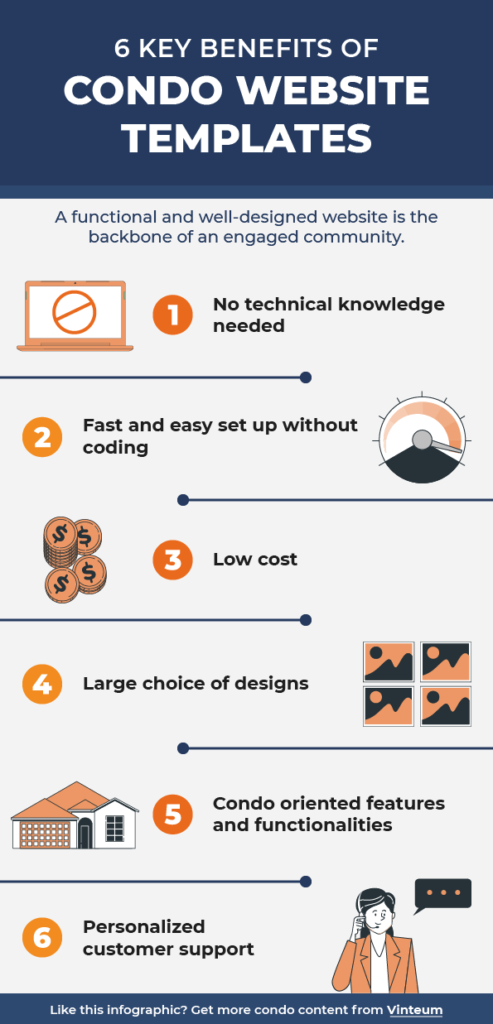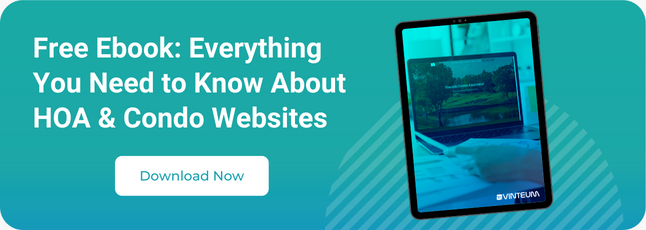The days when creating a condo association website involved huge costs and high-level technical skills are long gone. Nowadays, building a site is easier than it has ever been, and can cost as little as $30 per year. With the right tools and guidance, anyone can do it. However, without the right knowledge, developing a website can be challenging.
In this article, we will teach you how to make the most out of the solutions available. We will also go through best practices that will help you create your condo site effortlessly.
But if you want a simple, ready-to-use solution, Neigbrs by Vinteum offers a website designed specifically for HOAs and condos with a resident portal. Our platform makes it easy to set up and manage your association’s online presence complying with the law—no technical skills required. Book a free demo to see how it works!

What to include in a condo association website?
A condo association website should include information about your association, such as its location, size, history, and the amenities it offers. Having a condo website can increase interest from potential buyers since they can easily find you online and increase their interest in your community.

A condo website is also a central location for residents to find relevant information about their association. The condo board can store governing documents in it so residents can access them in a simple way. It is also a good place to post news such as:
-
- Upcoming community events
-
- Activities around the neighborhood
-
- Weather and natural disasters related updates
-
- Restaurants and shops nearby
-
- Condo maintenance updates
What are the advantages of a condo association website?
In recent times, websites have become condo boards’ favorite tools for three main reasons:
-
- It improves communication within the community
-
- It helps manage the condominium efficiently
-
- It reduces the board’s workload
Board members often feel like having a website is extra work. It is a common assumption to think that it will increase workload instead of reducing it. When you’re setting it up, and getting used to using your website it does take some time. However, once everything is set, you’ll save time on repetitive tasks, and be able to focus on what matters.
Unlike single-use online tools, websites have the advantage of centralizing many features and functionalities in one location. This means you can streamline processes and workflows. Also, promoting your property to potential buyers becomes easier. You just need to direct them to your site. This means you are promoting your property 24/7 with very little effort.
Obviously, all this is possible if you choose the right solution partner and you apply best practices. Often board members make the mistake of going for the cheapest option that doesn’t provide any support. This can lead to the board feeling overwhelmed at the initial phase, residents not seeing any benefits, and the project being abandoned.
Choosing the right condo association website provider, who will give you support and help you to reach your goals is key.

How do you create a condo association website?
There are 4 steps to creating a website for your condo:
1. Find a condo association website solution provider
There are two main ways to create a website:
1 – You can hire a web developer who will create your page from scratch based on your instructions. This option guarantees you a unique layout. This means you have total freedom in choosing the design, colors, fonts, and much more. Essentially, you don’t have limitations when it comes to the structure of your website.
This can have a lot of benefits for companies or associations with large budgets that need something very specific. It is not common for regular condo associations to choose this option since it is very costly and time-consuming. It can also be difficult to use when the web developer has handed over the website. Often you need to understand how the website was created to edit it.
2 – Use website templates provided by condo management software companies to create an easy-to-use website.
A website template is a ready-made site that your company can use and customize. Put simply, your only task is to add text and images to the template. The structure, the features, and the design are already set. While it doesn’t provide the same flexibility in terms of structure, most templates cover everything condo associations need.

Templates are so easy that anyone can quickly learn how to update or add content to the site. They are also cheap and quick to build. While creating a website from scratch may take weeks or even months, setting up a website with templates takes only a few hours.
2. Pick a condo website template
Once you have selected a solution partner, it is time to pick the best template for your association. Usually, a provider will provide several options. These templates may have different layouts, colors, or functions. You need to choose one that reflects your condo the best. For example, if your residents are mainly seniors make sure to choose a senior-friendly template with big fonts and good contrast.
You can also think about what matters the most for your website, do you want a lot of images or more text? You can also think about what your condo is like. If it’s more traditional, you can choose a template that reflects that.
3. Choose the domain
Your domain is the name of your website. For instance, if your community was called Sealights Condomonium, it could be www.sealightscondo.com, so when someone types your condo’s name in a search bar then your page should appear. You can choose to pay to have your own domain, which makes it easier for people to find you and makes you seem more trustworthy.
If this isn’t important for you, you can choose to use a subdomain for free. So that means that the provider’s name will appear in your website’s link. If we use the example of Sealights Condominium working with Neigbrs by Vinteum, your sub-domain would be www.sealights.vinteumneigbrs.com. This means that you wouldn’t pay extra, but you would decrease your authority.

4. Add content
Once you have picked your favorite template and chosen your domain, it is time to add text and images to your site. Here are some ideas of what you could add to your condo’s website:
-
- Your condo’s history
-
- General information
-
- Pictures of your condo
-
- Key documents
-
- Service providers ads
-
- Events or meetings that are coming up
-
- FAQs section (Frequently Asked Questions)
-
- Upcoming maintenance
-
- Amenities or services provided
Check out these condo website examples to inspire you. Our solution, Neigbrs by Vinteum is trusted by condos across North America to create their websites.
What are the best practices for creating a condo website quickly and effortlessly?
1. Assign responsibilities or create a committee
The best thing to do is to create a committee that will oversee the whole project. This guarantees more control, transparency, and engagement. If your association doesn’t have enough volunteers to build a committee then you should assign board members to specific tasks. If you have residents in your community that have worked with technology, that’s helpful as they will be able to assist you with choosing the best platform. That way they have different responsibilities, and nothing gets missed. Here are two important roles:
-
- Website project manager – the main point of contact and responsible for overseeing the whole project
-
- Content editor – responsible for creating, drafting, and uploading content
2. Choose a provider that offers support and onboarding
Even though launching a website using a template is easy, you will need support. Without initial help, these four steps to creating a website can become overwhelming. Luckily some companies offer support via chat and phone.
Some even offer onboarding sessions where they explain how the tool works. In these sessions, experts share with you tips and best practices. Some also help you add content to your website. Be aware that some companies do not offer this kind of customer support. So make sure you ask before you pick a solution provider. We believe that good customer service makes all the difference.
Some templates integrate with an online portal that is accessible to residents only. They may provide a member-only part of your website or a secure online portal. Such platforms allow the board to manage different aspects of condo management such as:
-
- Send emails and texts
-
- Manage payments and accounting
-
- Scheduling amenity reservations
-
- Track work orders
-
- Host virtual meetings
Having an all-in-one solution helps the condo board manage everything efficiently in one place. This cuts down the number of spreadsheets and different free tools that don’t integrate with one another.
4. Update your condo association website regularly
A common mistake associations make is to launch a website and never update it again. Static web pages don’t get engagement and don’t provide value over time. It is wrong to think that websites are done once and that’s it. Adding new content and removing old or outdated information is crucial. It is also important to frequently add news about your community. This will encourage residents to check your page to get informed. It will ensure that your website is used and appreciated.
5. Engage residents and potential buyers
Condos that have recently implemented a website often complain about the lack of engagement from their residents. It is important to regularly remind unit owners that your website exists. Otherwise, they will forget. Also, as mentioned above, if you don’t update your site regularly its traffic will automatically decrease. This is easier said than done. Many times condo boards don’t even know what to include in it. To solve this, ask residents what they would like to see on their association website. You can also ask prospective residents if they know about it and what they think of it. Conducting a survey can help you with that. This will generate a lot of new ideas for things to post online.
Wrapping Up Condo Association Websites
A condo association website is an essential tool to communicate efficiently with unit owners. The board doesn’t have to spend most of its time on repetitive tasks, such as answering the same questions over and over. It also helps to bring new owners, as they can find you. Thanks to new technologies, it is now possible to have an online presence without having to invest a huge amount of money. Choosing the right company and picking a good template is all you need to worry about.
Neigbrs by Vinteum is an award-winning solution, with award-winning support. We provide you with a website, a secure portal, and training to ensure that you get the most out of your website. Book your free demo to find out how we can be the right partner for you.




One Response
Contact Harvest Properties for all your property management needs. When you need property management, Harvest Props Provides the best services in Melrose, Newburyport and the greater North Boston area.